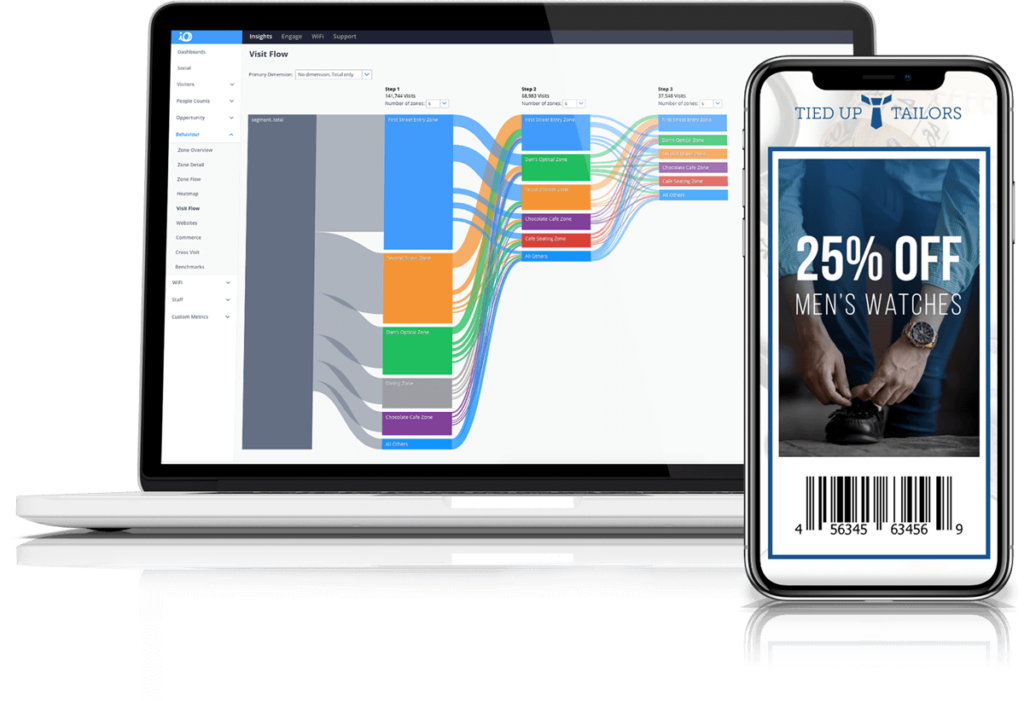How Data Can Help Retail Property Managers Make Smarter Leasing Decisions
.jpg?length=1200&name=blog-header-1200x600%20(14).jpg)
In today’s fast-paced retail property landscape, data-driven insights are crucial for success.
According to PwC research, highly data-driven organizations are 3x more likely to report significant improvement in decision-making.
Having the right data tools becomes paramount amid disruptions and shifting audience behaviors. Retail data analysis empowers leasing managers, offering insights into tenant mix, rate adjustments, store positioning, and more.
However, the amount of retail data available is substantial. That’s why leveraging a unified data platform to assimilate, analyze, and act on this data effectively is crucial. This solution gives retail property managers the insights to guide their leasing decisions strategically.
If you’re eager to turn data into your competitive edge, discover the transformative datasets every savvy retail property manager should use.
Market and Trade Area Analysis: Leveraging Modern Data
In retail, understanding your market and trade area is paramount. Retailers are leaning into various data sources to understand their market landscape better.
Leveraging these datasets informs day-to-day decisions and helps craft long-term, forward-thinking strategies that resonate with the market’s pulse.
Let’s explore how these datasets are driving market and trade area analysis:
1. Government Industry Data
Statistical data from governmental bodies encompass demographics, industry trends, economic indicators, and more.
Retail property groups must consider historical government industry data and trends to aid leasing decisions. This data helps determine the growth of various industries and predict the future performance of tenants.
It also helps to choose the best retail mix and ensure your tenants can pay rent in the future.
Why government industry data is invaluable:
- Benchmarking: Compare your store’s performance against industry averages or regional trends.
- Demographic Insights: Understand age, income, and other demographic variables of your target area, tailoring offerings accordingly.
- Economic Forecasting: Utilize economic indicators to predict potential market growth or downturns.
2. Traffic and Transit Data
This data provides road traffic volumes, public transit usage, and transportation patterns.
Google Directions API data can determine how far your target audience must travel within a specified area to your retail outlet. It can also distinguish which competitors or alternatives are most convenient within that area.
This data helps retail property groups understand which brands will effectively acquire customers based on travel times (convenience) and trade area.
These brand options will also modulate with travel time based on the hour of day, day of week, and week of year. Infrastructure changes can also impact the target demo’s retail options long-term.
Why traffic and transit data is invaluable:
- Accessibility Analysis: Determine how accessible your store is for drivers and public transit users.
- Optimal Timing: Adjust store hours or promotions based on peak traffic times.
- Location Strategy: Evaluate potential new store locations based on accessibility and traffic flow.
3. Transaction Data
This retail data is collected from sales transactions, including items purchased, purchase times, and transaction amounts.
Retail transaction data can help evaluate all spending patterns across a trade area. This helps retail property groups understand a retailer’s affinity, which can determine the right brands that fit the desired growth and spend.
In addition, trade area analysis can evaluate how your trade area is changing and how that affects the audience likely to visit. It also identifies what anchors and categories attract new audiences or extend your trade areas.
Why transaction data is invaluable:
- Product Popularity: Identify best-selling items or services in your store.
- Sales Patterns: Detect daily, weekly, or seasonal sales trends.
- Customer Loyalty: Track repeat customer transactions to gauge loyalty and tailor retention strategies.
4. Cellular Data (4G/5G)
Leverage data from mobile device usage, movement patterns, and connectivity in a particular area.
Cell data helps retail property groups understand where a customer originated and the route they took to get to a retail outlet.
Cell data can also provide a customer’s geo coordinates. This helps retail property groups understand customers’ travel paths to get to their retail venues. In addition, it helps determine a retail property’s trade area.
Why cellular data is invaluable:
- Consumer Movement: Understand where consumers are coming from and where they go after leaving your store.
- Engagement Analysis: Assess how often and how long consumers engage with your store’s online platforms while on-premises.
- Tech Profiling: Gauge the tech-savviness of consumers in your area, potentially guiding in-store tech investments.
Also Read: 4 Smart Retail Trends: Data Driving Efficiency and Growth
On-Premise Retail Consumer Behavior: Ways to Capture Data

In today’s retail industry, understanding on-premise consumer behavior is no longer a luxury—it’s a necessity.
With a wave of technological innovations, retail property managers can leverage data to reveal the intricacies of consumer habits.
Let’s dive straight in and uncover how retail data is reshaping the way leasing decisions are made:
1. People Counters: Capture Visitor Foot Traffic Data
People Counters are technological devices positioned at retail store entrances, exits, and critical areas to capture visitor foot traffic data.
Retail foot traffic data helps you understand and measure footfall. Use this data to inform tenant mix, rental premiums, and other data-driven decisions.
Ways retail property managers can use people counting data:
- Real-Time Traffic Analysis: Know when your retail space sees the most visitors with foot traffic analytics.
- Leverage Peak Hours: For instance, place a coffee shop near an office block entrance where morning traffic is bustling.
- Traffic Flow: Capture data to discover insights on store layout based on where customers naturally gravitate.
- Optimize Store Placement: Position stores based on the natural flow of consumer movement. For instance, place a children’s toy store where parents frequently pass.
- Improve Store Efficiency: If there’s high traffic but low sales, you may need to revisit store layout, pricing, or product mix.
- Optimize Staffing: Schedule more staff during peak times to meet customer needs.
- Evaluate Marketing Campaigns: Measure foot traffic before and after a campaign to gauge effectiveness.
2. Guest WiFi: Improve Customer Satisfaction and Boost Sales
Guest WiFi in retail offers shoppers internet connectivity through the store’s network. This service allows retailers to gather consumer data, send tailored promotions, and leverage insights to enhance customer experience and elevate sales.
WiFi location data can provide an understanding of when and where customers shop. WiFi data can also determine the destination of a customer’s visit and plot points of engagement within the shopper journey.
Ways retail property managers can use WiFi data:
- Collect Demographics: Gain insights into the age, gender, and even shopping preferences of your consumers.
- Engage Customers: Send real-time promotions directly to connected consumers or post-visit surveys to gather feedback.
- Optimize Retail Mix: Sensor data can determine customer behavior outside and across stores to help make decisions about the retail mix.
- Create Store Destinations: Retail property managers can share foot traffic data with associated tenants at various locations.
- Track Dwell Time: Understand which areas of your store capture the most attention and keep consumers engaged the longest.
- Store Layout Efficiency: Leverage data to recognize areas needing more enticing products or displays.
- Promotion Analysis: Measure the impact of in-store promotions or offers.
3. Retail Spend: Decoding Consumer Spending Patterns
Retail spend data derived from sales transactions captures the monetary amount consumers spend within retail outlets.
Property managers can make more informed and effective leasing decisions by leveraging the insights from monitoring retail spend.
Combined with other data points like foot traffic, it also offers a comprehensive understanding that can drive significant value in leasing decisions.
Ways retail property managers can use retail spend data:
- Determine Store Performance: Stores with consistently high retail spend might be good candidates for lease renewal or expansion.
- Identify Consumer Preferences: Know which products or services resonate most with consumers, allowing for better store placements or targeted marketing.
- Store Placement Decisions: Properties can strategically position high-performing brands or products, enhancing the overall shopping experience.
- Lease Negotiations: High retail spend can be a significant leverage point during lease negotiations, justifying rent rates and contract terms.
- Revenue Forecasting: Property managers can better forecast potential revenue streams and financial performance by understanding past spending trends.
- Promotional Partnerships: Identify brands or stores ideal for joint promotional efforts based on their performance.
- Combine with Foot Traffic: High foot traffic but low retail spend may indicate store layout or product range issues. Conversely, low foot traffic but high spend may mean a niche, high-value store.
- Enhancing Dwell Time Analysis: If consumers spend a lot of time in a store but spend little, there could be a mismatch in product pricing or the overall shopping experience.
The Importance of a Unified Data Platform: Turn Raw Data into Retail Gold


Retail data is essential, especially in the competitive world of retail. But with various data sources pouring in, how can retailers effectively make sense of it all?
The answer lies in a unified data platform like Skyfii. Here’s why it’s indispensable:
1. Centralized Data Collection
- What it means: Having all your data sources flow into one consolidated platform.
- Why it matters: It eliminates the need to juggle multiple systems. Manage data from a single source, making data retrieval efficient and streamlined.
2. Holistic View of the Customer Journey
- What it means: Capture every touchpoint from the moment a customer enters a store or visits a website to their purchase and feedback.
- Why it matters: By understanding the entire customer journey, retailers can identify potential pain points, optimize touchpoints, and enhance the overall shopping experience.
3. Seamless Integration
- What it means: A unified platform can effortlessly integrate with various data sources, from in-store people counters to online shopping carts.
- Why it matters: This integration allows for a richer, more comprehensive data set, which is invaluable in crafting informed strategies.
4. Real-time Decision Making
- What it means: As data flows in real-time, you can make decisions on the fly, adapting to ever-changing retail landscapes.
- Why it matters: Real-time data enables swift and informed actions, whether restocking a popular item or tweaking a marketing campaign.
5. Enhanced Personalization
- What it means: Understanding individual customer preferences becomes straightforward with all data points in one place.
- Why it matters: Tailored marketing campaigns, personalized offers, or even individualized in-store experiences can be crafted, resonating deeply with consumers and fostering loyalty.
6. Cost Efficiency and Scalability
- What it means: Maintaining a single unified platform is often more cost-effective than multiple disjointed systems. Plus, it can scale as a business grows.
- Why it matters: For retailers, efficient budgeting and forward-thinking scalability are vital for sustainability and growth.
7. Ensuring Data Consistency and Quality
- What it means: A unified system can provide standardized data processing and cleaning mechanisms.
- Why it matters: Clean, consistent data is the bedrock of any successful analytics initiative. This ensures accurate insights and strategic decision-making.
The Key Takeaways
We believe these datasets are the most helpful to aid in leasing decisions. A holistic view of retail data analytics empowers you to make smarter leasing decisions.
The key is to house your retail data in a platform that turns it into actionable analysis. This enables you to be proactive and better informed.
It’s also important to understand that most data-driven decisions are coupled with human expertise. An expert on leasing negotiations is integral to helping drive more informed decisions.
Ready to Make Smarter Leasing Decisions?
Skyfii offers a transformative leasing performance model tailored for retail.
Dive deep into tenant performance data with our streamlined dashboard. Glean insights from recommended rental rates, performance forecasts, and projected rental optimization opportunities.
Unlock the potential of your existing data without third-party dependencies. Ready to revolutionize your retail property business?
